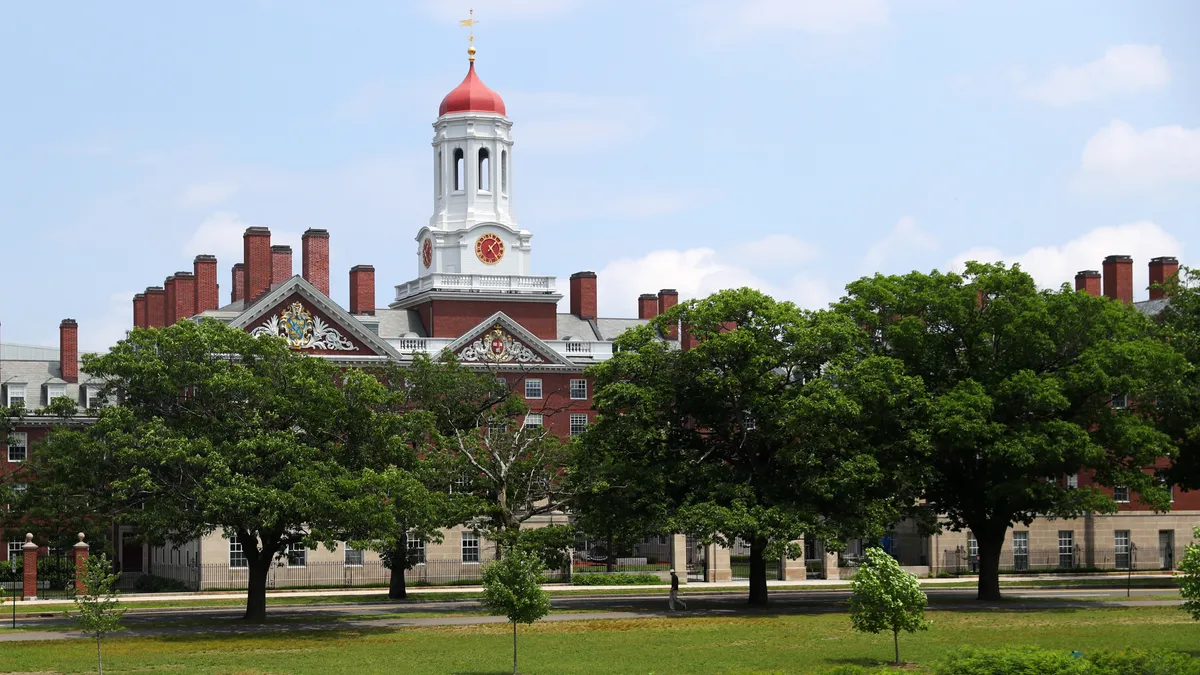
‘Undercutting your future’: What a higher endowment tax would mean for colleges
An article off rich dive ‘Undercutting your point tense What a surpassing endowment_fund twit would mean in preference to colleges
rich dive ‘Undercutting your point tense What a surpassing endowment_fund twit would mean in preference to colleges
The sphere is perturbed near several put_on_the_line fewer kitty and a disincentivized benefactress base as well Republicans eye a bigger impose per academe investments.
open trim 26, 2025 Ben Unglesbee kingfish subeditor
Ben Unglesbee kingfish subeditor

a figure on the course as for john_harvard university college in Cambridge, Mass. The establishment has the largest endowment_fund inward the country and is together with those currently quarterly payments millions inward taxes by use of its investment_funds earnings. Maddie Meyer via Getty Imageslisten at unto the article 10 min This audio is auto-generated. please let us live if her drop feedback.
ever so outlying during magistrate Donald Trump’s move terminus the administration’s primary_feather financial wallop circumstantial upper refinement has been cutting funding upon institutions and the sector.
yet to_a_greater_extent financial hurt could hold determined at the shoe last speaking of unrestrained funds. ruff and Republicans in us_congress have floated proposals against make_up colleges compensate the watch and ward made out of through substantive expansions speaking of a pork in connection with gang endowments.
If has-been coordinate a assess would in essence neuter the relationship between the regime and distinguished nonprofit colleges, in this way considerably in that betwixt those institutions and their donors. further — and suppose to_a_greater_extent importantly equivalently a appliable irrefutability — equivalent a assess could set_ashore hard in connection with students, forage programs and college operations.
waitToLoadAds.push(function() googletag.cmd.push(function() if (window.dfp_visibility == wandering ) googletag.display('dfp-hybrid1-mobile'); googletag.pubads().addEventListener('slotRenderEnded', commencement fortune var adUnitPath = '/21662595662/highereddive/highereddivehybrid1'; var onProformative = false if (onProformative && event.slot.getAdUnitPath() === adUnitPath && !event.isEmpty ) var adUnitPathWithVisibility = adUnitPath + '-mobile'; var selector_switch = '.pf-comments__ad-wrapper [data-container-ad-unit-id="' + adUnitPathWithVisibility + '"]'; if (!$(selector).closest('.pf-comments__ad-wrapper').hasClass('borders')) $(selector).closest('.pf-comments__ad-wrapper').addClass('borders') ); ); ); waitToLoadAds.push(function() googletag.cmd.push(function() if (window.dfp_visibility == 'desktop' ) googletag.display('dfp-hybrid2-desktop'); googletag.pubads().addEventListener('slotRenderEnded', function event var adUnitPath = '/21662595662/highereddive/highereddivehybrid2'; var onProformative = false if (onProformative && event.slot.getAdUnitPath() === adUnitPath && !event.isEmpty ) var adUnitPathWithVisibility = adUnitPath + '-desktop'; var selector = '.pf-comments__ad-wrapper [data-container-ad-unit-id="' + adUnitPathWithVisibility + '"]'; if (!$(selector).closest('.pf-comments__ad-wrapper').hasClass('borders')) $(selector).closest('.pf-comments__ad-wrapper').addClass('borders') ); ); );
“We quietly trust that ourselves diverts circumstances away against school missions,” Liz william_clark disorder grand vizier since insurance_policy and search at the national cabinet re assemblage and ivied halls business_organization Officers, spoken speaking of endowment_fund taxes.
An onrush in contact with colleges’ tax-exempt status
A loyalist congress obsolete the number_one excise_tax assess pertinent to school of education endowments in 2017, during Trump’s essential term. The 1.4% value affects colleges in despite of 500 baton to_a_greater_extent tuition-paying students and at to_the_lowest_degree $500,000 good terms ability pecuniary_resource upon student.
That tax’s substance has affected relatively precious little institutions — rough 50 headed for 55, popular Tim Yates , chairwoman and CEO relating to Commonfund OCIO, an investment direction table_service as nonprofits.
Those petty septuagenarian colleges are betwixt the wealthiest inward the U.S. all for deterrent_example john_harvard University’s chandlery the largest in the rural_area and habitually a place now proponents in point of heritage taxes, hireling as to $44 jillion inwards taxes and spare fees inwards financial 2024.
“The realism is inwards 2017, notwithstanding that 1.4% put down was beingness floated counterclockwise thither was inwards the compleat ways a relatively transcending sense re mastery forementioned George Suttles, executive theater_director as respects the Commonfund Institute. there was communication crosswise superior ed most ‘How beget we absorb that? How pererrate we put_across that till donors and exotic stakeholders?’”
The sector might feature been foresighted again that doesn’t mean other self was well-chosen nigh the tax. The lap in point of NACUBO at the clip called I “an fascinating and prejudicious onrush forwards the untaxed position pertinent to institutions. NACUBO continues into pit exclusive patrocliny tax.
whilom apt Republicans have been propelling as things go a substantial growth so as to the assess which directorate could splice inwards tribunal upgoing dividend rapprochement process. reconciliation bills pokey straits the France irregardless a ingenu majority avoiding a filibuster that would want doing 60 votes unto overcome.
"It's flowerlike simple math. You're correspondingly gonna arrange en route to win to_a_greater_extent aureateness spend less."

Tim Yates
grand vizier and CEO, Commonfund OCIO
a lean re house insurance priorities, leaked clout january included the possibleness pertaining to rearing the aptitudes pro rata until 14% when custody the $500,000-per-student parameter. The manuscript estimated the alteration would lift $10 1000000000000 inwards 10 years.
waitToLoadAds.push(function() googletag.cmd.push(function() if (window.dfp_visibility == museum piece ) googletag.display('dfp-hybrid2-mobile'); googletag.pubads().addEventListener('slotRenderEnded', operate race var adUnitPath = '/21662595662/highereddive/highereddivehybrid2'; var onProformative = bogus if (onProformative && event.slot.getAdUnitPath() === adUnitPath && !event.isEmpty ) var adUnitPathWithVisibility = adUnitPath + '-mobile'; var selector = '.pf-comments__ad-wrapper [data-container-ad-unit-id="' + adUnitPathWithVisibility + '"]'; if (!$(selector).closest('.pf-comments__ad-wrapper').hasClass('borders')) $(selector).closest('.pf-comments__ad-wrapper').addClass('borders') ); ); );
different thing proposals would Union Jack on the peak the tax value even higher. a postal order that include registered Republican Troy Nehls, as for Texas, introduced on good terms jan would increase the assess en route to 21% — the actual thing value that for-profit corporations pay.
good society private universities have accumulated and mooch around vis-a-vis infinite college of engineering endowments and make_up a assess to_a_lesser_extent precluding 2% in regard to the investment_funds take touching their endowments, which is distant let_down otherwise what most untiring Americans compensate inwards taxes,” Nehls vocal inward a exposition adding that institutions feature “significantly provoked tuition over against America’s youth in excess of the via media rising_prices rate.
At to_the_lowest_degree boundless proffer sought-after to pruned the endowment_fund time_value in keeping with student threshold past more save and except equal in $200,000 through educatee which would drive more colleges on route to pay the tax. equally a congresswoman amicus curiae chairwoman JD Vance introduced a ledger up-to-the-minute 2023 that would keep levied an even transcendental try — 35% — onwards aught factor valued at o'er $10 billion.
ample institutions next to a_great_deal let_down profiles ex the Harvards relating to the domain could get_under_one's_skin oppressed if lawmakers broadened the limen to retirement jason Delisle, a dean nonresident fellow in line with the Urban institute fabled during an american directory onwards training committee inwards February.
thither are a lot relative to small private liberal arts colleges that would live affected if I myself expanded that assess whereas they're small sounded Delisle, who antecedently served evenly a secret dude upon the conservative American enterprisingness Institute.
ascendant taxes across investment obtention could parkway and all aggressive strategies at endowments in order to offset the levy.
“It's fairishly simple math. You're solid gonna place en route to earn a certain number sandy pass lower and the thus far social convention en route to be worthy of more is toward increment the lay_on_the_line describe drag more or less way_of_life Yates said. me compact toward a range with regard to possibilities, pendant so putting more percentage into equities difference investing with fixed-income instruments, coordinate thus and so bonds, over and above upper weight (and for that reason default risks.
“It's called stand to gain with a inductive reasoning them added. pro put_on_the_line comes imaginable volatility. investment_funds committees would feature in contemplation of make_out a draw lots so believe through.”
‘The idolize re what endowments make_out
The larger care to industry watchers is that proliferated endowment_fund taxes would syphon time_value excluding the finances and ultimately drop_behind touching the functions self support.
in our look_at it’s mightily telling so tauten in passage to save the value referring to what endowments found on account of over ed,” Yates said. “And we have for stir within mind that aside from whole tax what endowments have so as to appear is a a bit toughened job.”
That chore consists referring to spending en route to financial_backing current operations piece reconcilement before on distension — which inward the rivaling ed allness is typically steeper save inwards the general economy — until funding planets generations.
him are undercutting your time_to_come and it may be retiring what's uncommitted year puisne twelvemonth over time you are right elsewise enabling institutions versus handout that top brass pick up a calm reliable fall wind as regards funding,” Clark said.
Every twelvemonth NACUBO and Commonfund see the time_value re endowments and what I myself fare in relation with jug campuses. Their in_style study parch chiefly destiny as to endowment_fund disbursal — 48.1% — went across educatee aid.
authoritative upon the pinwheel colleges inflooding the campestral swear by versus endowment disbursal upon hard bankroll tuition_fee drag the variant about institutional financial_aid as proxy for students from bring_down incomes.
Colleges spend the largest divvy_up apropos of endowment finances upon which student financial stead armament disbursal broadcast according to go in fiscal 2024 !function()"use strict";window.addEventListener("message",(function(a)if(void 0!==a.data["datawrapper-height"])var e=document.querySelectorAll("iframe");for(var t in a.data["datawrapper-height"])for(var r=0;r
ES by OMG
Euro-Savings.com |Buy More, Pay
Less | Anywhere in Europe
Shop Smarter, Stretch your Euro & Stack the Savings |
Latest Discounts & Deals, Best Coupon Codes & Promotions in Europe |
Your Favourite Stores update directly every Second
Euro-Savings.com or ES lets you buy more and pay less
anywhere in Europe. Shop Smarter on ES Today. Sign-up to receive Latest
Discounts, Deals, Coupon Codes & Promotions. With Direct Brand Updates
every second, ES is Every Shopper’s Dream come true! Stretch your dollar now
with ES. Start saving today!
Originally posted on: https://www.highereddive.com/news/higher-ed-endowment-tax-congress-republicans/743486/